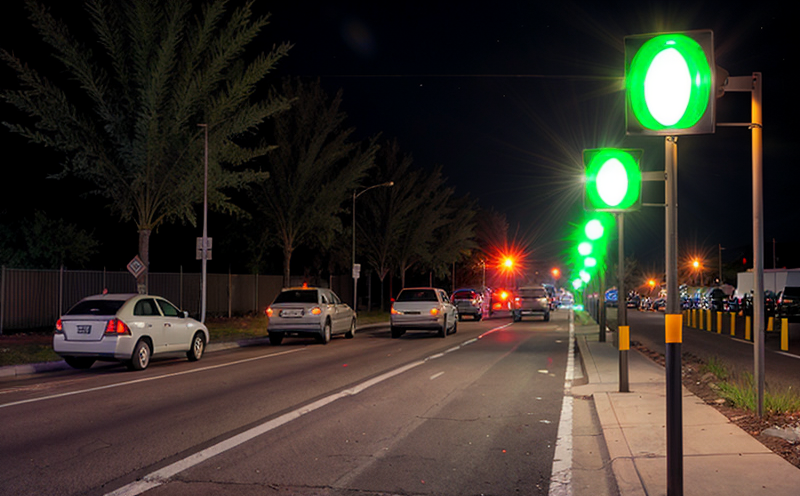ASTM D570 Water Absorption Testing of Traffic Signal Plastics
The ASTM D570 standard is widely recognized for its rigorous method to quantify the water absorption capacity of plastics, which is critical in ensuring the durability and reliability of traffic signal components. This test evaluates how much moisture a material can absorb under specific conditions, providing insights into the potential degradation caused by environmental factors such as rain or snow. In the context of traffic signaling, this information is paramount for selecting materials that maintain their integrity over extended periods exposed to the elements.
The testing process involves submerging the specimen in distilled water at a controlled temperature, usually 23°C ± 1°C, and measuring its weight before and after exposure. The difference in weight provides an accurate measure of the material's ability to absorb moisture. This data is then used by manufacturers to optimize their products for performance under real-world conditions.
For traffic signals, which are often exposed to harsh environmental conditions, ensuring that materials can withstand water absorption without significant degradation is crucial. The ASTM D570 test helps ensure that the plastics used in these components maintain their strength and clarity over time, thereby enhancing safety and reliability of the signaling system.
The importance of this testing cannot be overstated, especially considering the critical role traffic signals play in road safety. By accurately assessing how materials perform under water absorption conditions, engineers can make informed decisions that lead to safer and more efficient traffic management systems.
In summary, ASTM D570 is a vital tool for ensuring the long-term performance of traffic signal components made from plastics. It provides essential data that aids in selecting appropriate materials, optimizing designs, and improving overall safety and reliability of these critical infrastructure elements.
Why It Matters
The water absorption capacity of traffic signal plastics is a key factor in determining the longevity and performance of these components. Water absorption can lead to several issues, including reduced mechanical strength, changes in color and transparency, and increased susceptibility to cracking or breaking under stress.
These effects are particularly concerning for traffic signals, which must remain functional even in adverse weather conditions. The constant exposure to moisture can cause materials to expand and contract, leading to fatigue cracks that may eventually compromise the integrity of the signal. This not only affects the reliability of the signaling system but also increases maintenance costs and reduces operational efficiency.
By conducting ASTM D570 testing, manufacturers and quality control teams can identify potential weaknesses in their materials early on, allowing for timely adjustments to formulations or design changes. This proactive approach ensures that the final products meet stringent performance standards, thereby enhancing both safety and reliability of traffic signals across various environments.
The results from this test help establish a baseline for material selection and quality assurance processes, ensuring that only those materials capable of maintaining their integrity under water absorption conditions are used in production. This commitment to quality is essential for maintaining public confidence in road safety infrastructure.
Benefits
The benefits of ASTM D570 testing extend beyond just the manufacturing process; they also impact users and maintainers of traffic signal systems. Here are some key advantages:
- Enhanced Durability: Materials that perform well in water absorption tests tend to last longer, reducing maintenance needs.
- Improved Safety: Reliable traffic signals contribute significantly to road safety by providing clear and accurate guidance to drivers.
- Cost Efficiency: By identifying problematic materials early in the development stage, companies can save on production costs through fewer reworks or scrap.
- Environmental Considerations: Longer-lasting components mean less frequent replacement, which reduces waste and environmental impact.
In conclusion, ASTM D570 testing offers a comprehensive approach to material evaluation that supports both the quality assurance process within manufacturing facilities and the broader goals of improving road safety and sustainability.
Industry Applications
| Application | Description |
|---|---|
| Traffic Signal Poles | Ensures that the materials used in poles can withstand environmental factors without compromising structural integrity. |
| Lights and Reflectors | Guarantees that lights remain bright and reflectors maintain their visibility under various weather conditions. |
| Cables and Wiring | Avoids insulation breakdown due to moisture, which could lead to electrical failures and safety hazards. |
| Enclosures and Housing | Prevents corrosion inside enclosures that might otherwise affect internal components and signal functionality. |
| Application | Description |
|---|---|
| Optical Components | Maintains clarity and transparency, crucial for accurate signaling in complex urban environments. |
| Safety Markings | Ensures that markings remain visible and legible under wet conditions, enhancing visibility during inclement weather. |
| Environmental Monitoring Equipment | Avoids malfunctions due to water absorption in sensors or other electronic components, ensuring accurate data collection. |
| Construction Materials | Prevents premature aging of materials used in temporary traffic management systems, extending their usability and effectiveness. |





